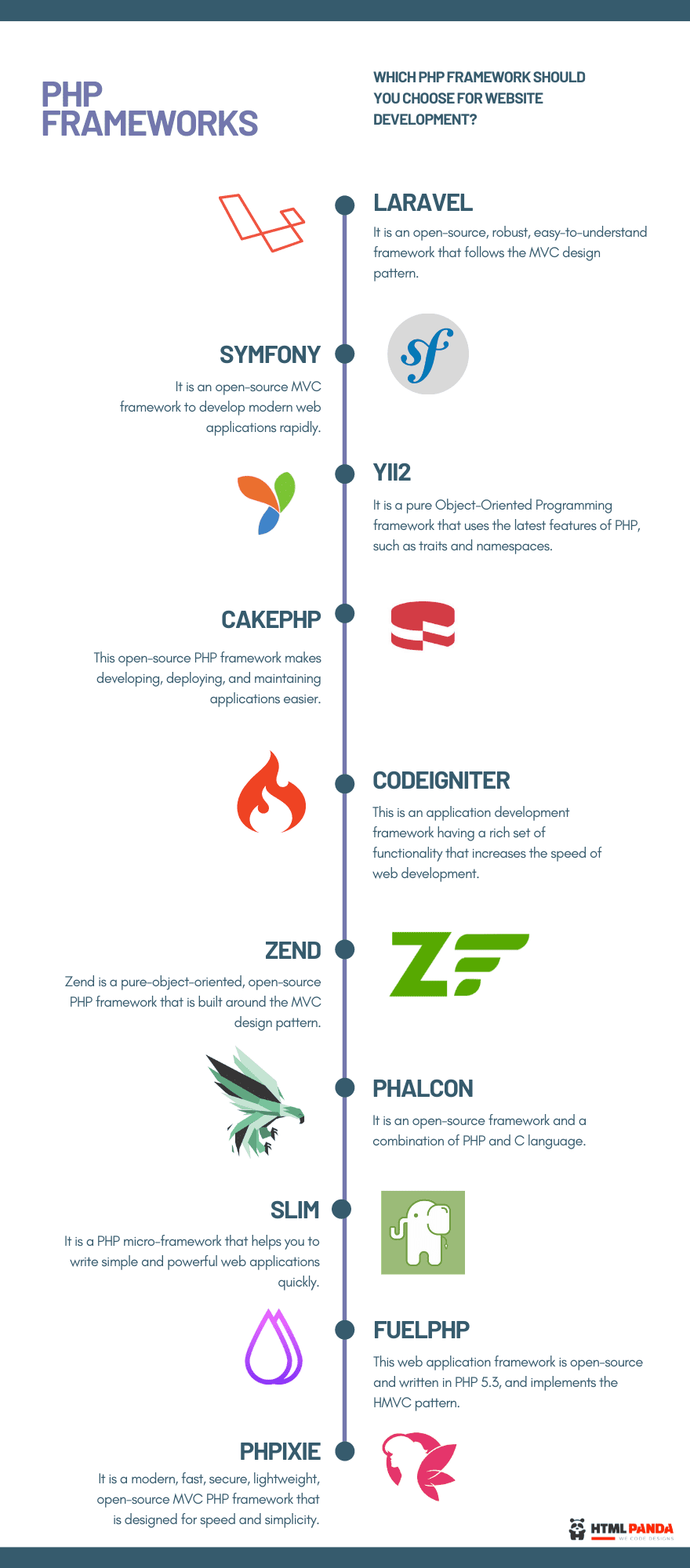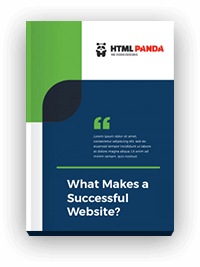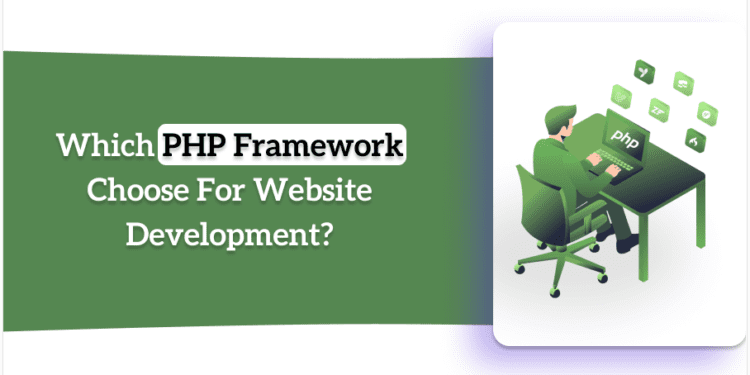Over time, websites have become more complex and demanding. They now deliver far more value as compared to yesteryears. It can be complicated to write a PHP script from scratch. And in some cases, we need to write a similar function many times, which will be time-consuming.
PHP frameworks make the process easy by streamlining these processes. These tools simplify the web development process by including pre-made code libraries and components to avoid repetitive coding.
Wondering which PHP framework is best for web development? Then you are at the right place.
Here, we will discuss the top 10 best PHP frameworks to choose from.
But first, let’s discuss the need to choose a PHP framework for web development services.
Why Choose a PHP Framework For Web Development Services?
PHP is one of the most known languages in the developer community after HTML, CSS, and JavaScript. Around 78% of websites use it worldwide, including Facebook. So, almost 8 out of 10 websites you visit on the internet use PHP somehow.
If we talk about the PHP framework, it is a platform to build PHP web applications that offer code libraries for the commonly used features. Moreover, It also reduces the amount of original code to write.
There are some more benefits such as –
- Saves Development Time – Rather than writing your own code, PHP Frameworks includes built-in functions that allow you to cherry-pick code.
- Good Coding Practice – PHP frameworks facilitate you to write code in an organized manner. They also partition the code into directories based on their functions, making the script easier to work.
Furthermore, the PHP framework provides various benefits such as faster development, libraries for common tasks, easier to maintain, less code to write, and efficient work with databases.
Irrespective of the framework, you can also opt for a PHP development company that supports your web application testing requirements. Some PHP web development companies offer cutting-edge and cost-effective web solutions for startups, enterprises, and mid-scale businesses.
Every framework has its own set of features. They vary in terms of community support documentation and official support from the creator. So, first, understand the project requirements and applications you want to develop. After that, choose the most suitable framework from the list.
Top 10 Best PHP Frameworks
Choosing the best framework depends on factors like security, documentation, scalability, and many more. So, here we have shortlisted the best PHP frameworks, and you can select any one of them based on your requirements.

1 – Laravel
It was introduced in 2011 and has become the most popular free and open-source PHP framework globally. This is because it is faster than other frameworks and can securely handle typical web applications. It has various inbuilt features that support rapid application development.
There are 3000+ companies that use the Laravel PHP framework. Some are Mastercard, Razorpay, Olx, Wattpad, TransferGo, etc.
Reasons to Use Laravel
- It is suitable for developing applications with complex backend requirements.
- It is full of features that enable the customization of web applications to meet the developer’s requirements. Some of the features it includes are seamless data migration, routing, security, authentication, MVC architecture support, etc.
- It is a good option for developers who build B2B or enterprise websites.
- It has good support from the PHP developer community, so it is constantly updated.
Cons of Using Laravel
- Laravel requires a separate admin panel to manage and edit content.
- It has limited inbuilt support.
- It might seem complex at first.
2 – Symfony
It has a large community of over 3,00,000 developers. It is a highly recommended framework due to its advanced features and easy-to-understand environment. It was launched in 2005 and has been in existence longer than most PHP frameworks. It represents that it has gained the developer’s trust over the years.
It is packed with many features, and its modular component system is very flexible, allowing developers to pick and select the components for their projects.
Some examples of companies that use the Symfony framework are BlaBlaCar, Spotify, Magento, Statista, Practo, Naukri.com, etc.
Reasons to Use Symfony
- Symfony is easier to install on most platforms, making it the best choice for developing enterprise-level applications.
- Its key features are reusable PHP components, following best practices and design patterns, stability, and database engine independence.
Cons of Using Symfony
- Laravel focuses more on simplicity and is easy to use even for intermediate developers and beginners. Unlike Laravel, Symfony mainly targets advanced developers and is a bit harder to start with.
- Because of its feature-rich nature, it can also be a little slower than other frameworks.
- The security mechanism of Symfony is a bit difficult to use.
3 – Yii2
It is a high-performance, component-based, and simple-to-use PHP framework to develop modern web applications. It is suitable for every web application type, making it a universal web development framework. It is easy to integrate with jQuery and AJAX functions; therefore, it is ideal for developing large websites.
Moreover, it has a strong class code generator called Gii that helps to simplify the object-oriented programming process and rapid prototyping.
Some of the companies that use Yii2 for their web application are Fujitsu, Lenovo, Deloitte, Discovery, etc.
Reasons to Use Yii2
- The documentation of Yii2 is well-written and easy to follow, so it is easy to install and set up.
- It includes robust security features like authentication, encryption, bcrypt password hashing making it an excellent option for building highly secure projects like e-commerce, CMS, etc.
- Yii has excellent performance, elegant caching support, and a code generator, making it an ideal choice for developers to create optimized web applications.
- Yii provides components and classes to handle requests, displaying data, Working with databases,
Cons of Using Yii2
- In Yii2, the AJAX features are not well-drafted, so developers have to use JavaScript whenever required compulsorily.
- Novice programmers find it boring and difficult to run from it as learning Yii requires quite enough knowledge of PHP, programming skills, and the different add-ons it comes with.
- It does not provide AR queries or support to build up multiple relations.
4 – CakePHP
CakePHP is already a decade-old framework, but still, it is the most popular PHP framework.
It is an open-source PHP framework that is simple and elegant and helps you develop visually impressive feature-loaded websites. It is one of the easiest frameworks to learn, mainly because of its CRUD (Create, Read, Update, and Delete) framework.
Some examples of companies that use CakePHP for their web applications are – Hyundai, BMW, MIT, Edureka, Blendtec, etc.
Reasons to Use CakePHP
- It is easy to install as a framework’s copy and a web server and is only required to get started.
- Security features such as methods for encryption, password hashing, input validation, SQL injection prevention, etc., make CakePHP an excellent choice for building enterprise-level applications.
- Other features of CakePHP include validation, a modern framework, premium, and documentation support.
Cons of Using CakePHP
- The documentation of the CakePHP framework is not as comprehensive as other frameworks.
- A one-way routing in CakePHP often proves to be a disadvantage compared to other PHP frameworks.
- In CakePHP, one has to update the default routes for making the URLs compared to other frameworks.
5 – CodeIgniter
It is an open-source rapid development framework used to build dynamic sites with PHP. EllisLab released its first version on 28th February 2006.
Developers who require a simple and elegant toolkit to create full-featured web applications can use CodeIgniter, which is indeed a robust PHP framework. It includes a rich set of functionality that increases the site’s speed. If you are developing a website from scratch, then CodeIgniter will save you a lot of time of.
Some of the essential features of the CodeIgniter PHP framework are – MVC based system, Query builder database support, extremely lightweight, data encryption, benchmarking, localization, etc.
There are 1700+ companies that use the CodeIgniter PHP framework. Some of them are – Buffer, Geekyants, Ola, Accenture, BigBazar, etc.
Reasons to Use CodeIgniter
- It supports MVC (Modern View Controller) patterns of coding and development.
- Unlike other frameworks, CodeIgniter is a more lightweight and straightforward PHP framework. It is ideal for beginners due to its simple setup process and highly illustrated documentation.
- It is considerably faster when compared with other frameworks. It offers solid performance and is a good choice when developing lightweight applications to execute on modest servers.
- CodeIgniter PHP development is generally compatible with various operating systems, most web servers, and platforms.
Cons of Using CodeIgniter
- Unlike modern PHP frameworks, CodeIgniter does not support the modular separation of code. So, programmers have to put extra time and effort into updating or maintaining the code.
- It has irregular releases.
6 – Zend Framework
It includes various features such as cryptographic coding tools, a user-friendly drag, and drop editor, a connected database wizard, and instant online debugging tools. The editor of Zend Framework supports front-end technologies such as HTML, CSS, and JavaScript. It is extremely usable and follows basic PHP practices that are very helpful to developers who want to integrate specific project features.
This PHP framework is packed up with many advanced features that make it easy for developers to create robust applications.
Some examples of the companies that use the Zend Framework are – Directus, Zingat, Webedia, etc.
Reasons to Use Zend Framework
- It is perfect for complex and enterprise-level projects.
- It has good documentation and an extensive community database. Some key features of Zend Framework include simple cloud API, data encryption, MVC components, and session management.
Cons of Using the Zend Framework
- Zend plugins come at a high cost, making them more expensive and less suitable for projects on a tight budget.
- It is not ideal for small projects as the entire framework is extensive and has a relatively slow operation speed.
7 – Phalcon
It is a comparatively different PHP framework based on C and C++ coding styles. It is loaded with exceptional features such as asset management, caching, universal autoloader, translation, security, and much more.
Phalcon is a very well-documented and easy-to-use framework. You do not have to worry about the C programming knowledge, as Phalcon is delivered as a web server extension written in C.
Some examples of companies that use the Phalcon framework are – SocialVeo, KingHost, PlaceOnAir, etc.
Reasons to Use Phalcon Framework
- It is easy to install and good to create highly configurable web applications.
- Phalcon optimizes the performance because of its efficient memory usage. Furthermore, it also does not use file reads and statistics.
- It is loosely coupled, allowing the developers to create their own directory structure.
- It natively supports PostgreSQL, SQLite, and MySQL.
Cons of Using the Phalcon Framework
- It is not very popular, so it has a small community that means answers to your questions and solutions to your mistakes can not be found easily.
- When designing a pattern, a deep knowledge of the functionality of this PHP framework is required.
8 – Slim Framework
It is a PHP micro-framework that helps developers to create powerful APIs and web applications. In a full-stack framework, you get components, classes, authentication, routing, paging, etc. But in a micro-framework like Slim, you get minimum support for HTTP requests and routing requests to appropriate controllers.
Then why choose a micro-framework? It is because it gives you high extensibility and flexibility. Some examples of the companies that use the Slim PHP framework are – Bootiq, GreenBot, Gamned, etc.
Reasons to Use Slim Framework
- It is easy to learn.
- Key features of Slim Framework include URL routing, session, client-side HTTP caching, and more.
- Slim is the best option for a web application that does not necessarily require a full-stack PHP framework. Moreover, friendly documentation and active maintenance make Slim more user-friendly.
Cons of Using the Slim Framework
- It unnecessarily loads the server with a large PHP file.
- It is hard to use model properties in the Slim framework.
- Dependency injection in the Slim framework is too weak.
9 – FuelPHP
FuelPHP is purely an object-oriented approach, and its architecture is based on the idea of modularity. It is a flexible, full-stack PHP framework first released in 2011. It is an open-source web application framework written in PHP 5.3 and implements the HMVC (Hierarchical Model View Controller) pattern.
Some examples that use the FuelPHP framework are – Canine Principles, CG Forge, Top Web Comics, and Betterplace Academy.
Reasons to Use FuelPHP
- It helps developers to deliver end-to-end web solutions that are diverse in size and complexity.
- It extends its security approach beyond actual security measures, making it a great option if security is crucial for your project. It handles encryption, decryption, and hashing by using powerful PHPSecLib.
Cons of Using the FuelPHP
- It is not friendly for beginners.
- It does not have a much active developer community similar to other frameworks.
- The developer needs to learn whenever a new version is released because the documentation guide keeps changing.
10 – PHPixie
PHPixie is an open-source, lightweight MVC-based framework specially designed for rapid development, simplicity, and speed. It was introduced in 2012 started as a micro framework, and grew to be one of the most popular full-stack PHP frameworks while keeping its high performance.
Some examples that use the FuelPHP framework are – Canine Principles, CG Forge, Top Web Comics, and Betterplace Academy.
Reasons to Use PHPixie
- It is easy to learn and understand with basic PHP knowledge.
- It includes an impressive routing system.
- It is a Lightweight framework with MongoDB support.
- It supports HMVC architecture.
- It focuses more on the speed and page loading time of the website.
- It is helpful to develop simple and enterprise applications.
Cons of Using the PHPixie
- It includes a smaller number of modules.
- It is not very popular and still in its growing state.
- It has less community support.
Conclusion
Using a PHP Framework makes the development process easier and helps to reduce the workload. Every framework has its strengths and weaknesses, and they vary in terms of documentation, community, and the database they support.
All the frameworks discussed in the article are free and open-source. So, you can opt for any of them that fits your requirements.










